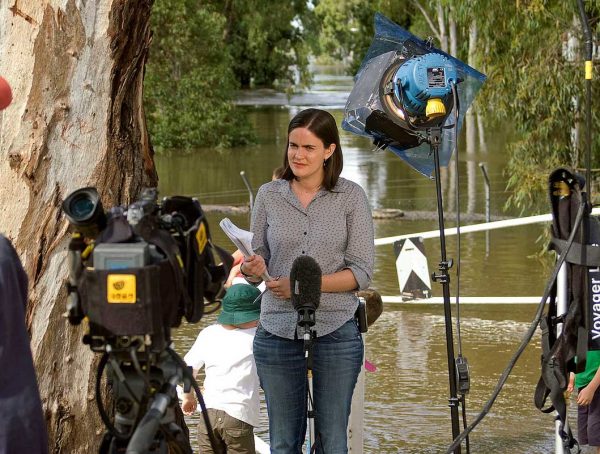By Dave Cupp & Ann Utterback
 Much has been written about the new and varied media platforms journalists are now asked to master, but one area that has not been explored is what delivery style works best on these new devices…
Much has been written about the new and varied media platforms journalists are now asked to master, but one area that has not been explored is what delivery style works best on these new devices…
…We are no longer captives in our homes or offices when we watch television. Now we hold the news in the palm of our hand and watch it anywhere. The use of headphones increases the intimacy (Wenger & Potter, Advancing the Story, 2008). What once was broadcast from across the room is now inside our heads.
To be effective in this era, the broadcaster needs to discard the lectern, step down off the stage and mingle on the same level with the listener. Just as “announcing” didn’t make a smooth transition into the more conversational “Eyewitness News style,” the delivery we hear today in television news isn’t making a comfortable transition to the new electronic platforms.
So what delivery will work for the new platforms? One of the pioneers in Internet political coverage on You Tube, James Kotecki, put it like this:
The most important thing… to relay a good image to You Tube viewers is just to relax and not treat this like …an appearance on a place like Fox News…. just learn that low production values can be a very positive thing as long as they’re relaxed and they’re talking directly to the camera and responding directly to You Tube viewers and relating to them as human beings…. (“Fox and Friends,” 3/31/07)
So we can take a cue from You Tube. Viewers want a delivery that feels like the person is having a latte with them at Starbucks. They are, after all, often holding that person in their hand as they watch on their iPhone or Blackberry. It’s not Enlarged Conversation any longer and the idea of standing behind a lectern on a stage and pontificating the news is surely out of date.
Today’s delivery needs to have the feel of a two-way conversation. Call it Connected Chatting. This delivery still must be clear and understandable, however, and it cannot be sloppy or totally spontaneous. There still need to be filters in the speaker’s head that filter out inappropriate language or verbal fillers (e.g., “uh,” “okay,” “like”), but rather than sounding like a script being read, it should sound like a casual chat.
What is causing current television news products that appear on the Internet to fail is the simple transfer of television news programs to the Internet and onto handheld devices without any thought to the delivery style being used. The things that make broadcast delivery work on television are not the same things that will make it work on the Internet. Simply uploading an evening newscast or packages to the Internet ignores the obvious difference in media.
It’s always easier to hold onto the old style of announcing, but just as the booming voices of the 1950’s did not work on the Eyewitness News style of the 1970’s, that style is not making an easy transition to the 2000’s. You Tube with its viral videos is telling us what works. Journalists have much to offer as ethical, educated reporters of the news, but if they are to be heard, they must change their delivery style to meet the times.
This post is excerpted from a revised edition of The Broadcast Voice Handbook, as yet unpublished. Here’s the entire chapter [PDF].








